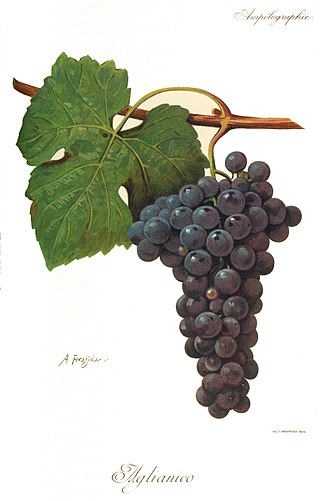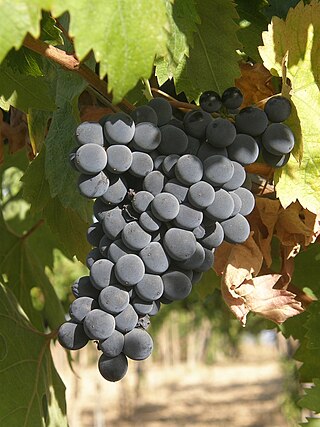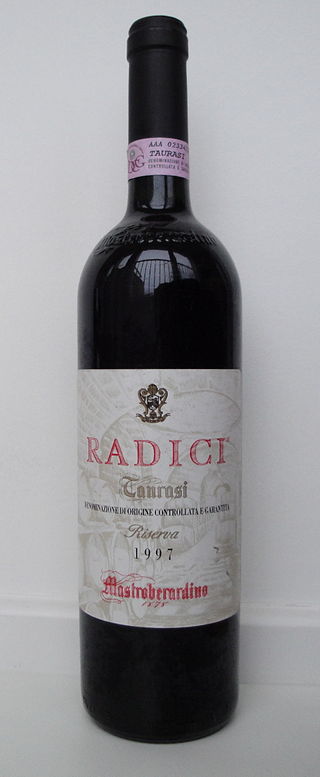
Chianti is an Italian red wine produced in the Chianti region of central Tuscany, principally from the Sangiovese grape. It was historically associated with a squat bottle enclosed in a straw basket, called a fiasco. However, the fiasco is now only used by a few makers of the wine; most Chianti is bottled in more standard-shaped wine bottles. In the latter nineteenth century, Baron Bettino Ricasoli helped establish Sangiovese as the blend's dominant grape variety, creating the blueprint for today's Chianti wines.

The following four classifications of wine constitute the Italian system of labelling and legally protecting Italian wine:

Aglianico is a black grape grown in the southern regions of Italy, mostly Basilicata and Campania. It is considered with Sangiovese and Nebbiolo to be one of the three greatest Italian varieties. Aglianico is sometimes called "The Barolo of the South" due to its ability to produce highly refined, complex fine wines like the famous wine from Piedmont, Barolo.

Vernaccia di San Gimignano is a white Italian wine, made from the Vernaccia grape, produced in and around the Italian hill town of San Gimignano, in Tuscany. It was the first Italian wine to be awarded denominazione di origine controllata (DOC) status in 1966; on July 9, 1993, it was upgraded to denominazione di origine controllata e garantita (DOCG).

Brunello di Montalcino is a red DOCG Italian wine produced in the vineyards surrounding the town of Montalcino, in the province of Siena, located about 80 km south of Florence, in the Tuscan wine region. Brunello, a diminutive of bruno, is the name that was given locally to what was believed to be an individual grape variety grown in Montalcino. In 1879 the province of Siena's Amphelographic Commission determined, after a few years of controlled experiments, that Sangiovese and Brunello were the same grape variety, and that the former should be its designated name. In Montalcino the name Brunello evolved into the designation of the wine produced with 100% Sangiovese.

Soave is a dry white Italian wine from the Veneto region, in northeast Italy, principally around the city of Verona. Within the Soave region are both a denominazione di origine controllata (DOC) zone and, since 2001, a denominazione di origine controllata e garantita (DOCG) designation known as Soave Superiore, with both zones being further sub-divided into a general and Classico designation for the wines produced in the heartland of the Soave region, around the sloping vineyards of Verona.

Aglianico del Vulture and Aglianico del Vulture Superiore are Italian red wines based on the Aglianico grape and produced in the Vulture area of Basilicata. Located on volcanic soils derived from nearby Mount Vulture, it was awarded Denominazione di Origine Controllata (DOC) status in 1971. The Superiore was elevated to a separate Denominazione di Origine Controllata e Garantita (DOCG) status in 2011, the only DOCG wine in Basilicata.

Barbaresco is an Italian wine made with the Nebbiolo grape. Barbaresco is produced in the Piedmont region in an area of the Langhe immediately to the east of Alba and specifically in the comunes of Barbaresco, Treiso and Neive plus that area of the frazione San Rocco Seno d'Elvio which was once part of the comune of Barbaresco and now belongs to the comune of Alba. It was granted Denominazione di origine controllata (DOC) status in 1966 and Denominazione di Origine Controllata e Garantita status in 1980. The wine is often compared with Barolo—another Nebbiolo-based wine from the Piedmont area. Though the wines do share many similarities, there are some distinct differences between them.

Montepulciano d'Abruzzo is an Italian red wine made from the Montepulciano wine grape in the Abruzzo region of east-central Italy. It should not be confused with Vino Nobile di Montepulciano, a Tuscan wine made from Sangiovese and other grapes.

Bardolino and Bardolino Superiore are Italian red wines produced along the chain of morainic hills in the province of Verona to the east of Lake Garda. Bardolino takes its name from the town Bardolino on the shores of Lake Garda and was awarded Denominazione di origine controllata (DOC) status in 1968. The Superiore is a stronger aged wine, and was promoted to Denominazione di origine controllata e garantita (DOCG) status in 2001. The blend of grapes used to produce the wine primarily includes Corvina, Rondinella, and Molinara. Up to 15% of the blend is allowed to include Rossignola, Barbera, Sangiovese, or Garganega, in any combination.
Gattinara is a red Italian wine with denominazione di prigine controllata e garantita (DOCG) status produced from Nebbiolo grapes grown within the boundaries of the comune of Gattinara, which is located in the hills in the north of the province of Vercelli, northwest of Novara, in the Piedmont region. It was awarded DOC status in 1967 and received its DOCG classification in 1990.

Piemonte wine is the range of Italian wines made in the region of Piedmont, in the northwestern corner of Italy. The best-known wines from the region include Barolo and Barbaresco. They are made from the Nebbiolo grape. These wines are ideal for storage and a well-aged Barolo for instance may leave a feeling of drinking velvet because the tannins are polished and integrated more and more into the wine. As the wine matures the colour becomes more brownish and rust-red.

Lombardy wine is the Italian wine produced in the Lombardy region of north central Italy. The region is known particularly for its sparkling wines made in the Franciacorta and Oltrepò Pavese areas. Lombardy also produces still red, white and rosé wines made from a variety of local and international grapes, including Nebbiolo wines in the Valtellina region and Trebbiano di Lugana white wines produced with the Chiaretto style rosé along the shores of Lake Garda. The wine region currently has 22 denominazione di origine controllata (DOC), 5 denominazione di origine controllata e garantita (DOCG) and at least 13 indicazione geografica tipica (IGT) designations. The main cities of the region are Milan, Bergamo and Brescia. The region annually produces around 1.3 million hectolitres of wine, more than the regions of Friuli-Venezia Giulia, Marche, Trentino-Alto Adige/Südtirol and Umbria.

Tuscan wine is Italian wine from the Tuscany region. Located in central Italy along the Tyrrhenian coast, Tuscany is home to some of the world's most notable wine regions. Chianti, Brunello di Montalcino and Vino Nobile di Montepulciano are primarily made with Sangiovese grape whereas the Vernaccia grape is the basis of the white Vernaccia di San Gimignano. Tuscany is also known for the dessert wine Vin Santo, made from a variety of the region's grapes. Tuscany has forty-one Denominazioni di origine controllata (DOC) and eleven Denominazioni di Origine Controllata e Garantita (DOCG). In the 1970s a new class of wines known in the trade as "Super Tuscans" emerged. These wines were made outside DOC/DOCG regulations but were considered of high quality and commanded high prices. Many of these wines became cult wines. In the reformation of the Italian classification system many of the original Super Tuscans now qualify as DOC or DOCG wines but some producers still prefer the declassified rankings or to use the Indicazione Geografica Tipica (IGT) classification of Toscana. Tuscany has six sub-categories of IGT wines today.

Fiano is a white Italian wine grape variety that is grown primarily in the Campania region of southern Italy and on the island of Sicily. In Campania, this fairly strong flavored white wine grape is particularly noted around Avellino where the Denominazione di origine controllata e Garantita (DOCG) wine of Fiano di Avellino is produced. The grape has a long history in the Campanian region and is believed to have been the grape behind the ancient Roman wine Apianum. Even today, the name Apianum is permitted to appear on wine labels of the DOCG wine Fiano di Avellino.

Carmignano is an Italian wine region located in the Tuscany region and centered on the city of Carmignano, about 10 miles northwest of Florence. Noted for the quality of its wines since the Middle Ages, Carmignano was identified by Cosimo III de' Medici, Grand Duke of Tuscany as one of the superior wine producing areas of Tuscany and granted special legal protections in 1716. In the 1800s, the producers of the Carmignano region developed a tradition of blending Sangiovese with Cabernet Sauvignon, long before the practice became popularized by the "Super Tuscan" of the late 20th century. In 1975, the region was awarded Denominazione di origine controllata (DOC) status and subsequently promoted to Denominazione di Origine Controllata e Garantita (DOCG) status in 1990. Today Carmignano has approximately 270 acres (110 ha) planted, producing nearly 71,500 gallons of DOCG designated wine a year.
Abrusco is a red Italian wine grape variety grown primarily in the Tuscany region where it is a minor blending component permitted in the wines of Chianti. The grape has long history in the region and was mentioned in 1600, under its synonyms Abrostino and Colore, in the posthumously published work by Italian agronomist Giovan Vettorio Soderini Trattato della coltivazione delle viti, e del frutto che se ne può cavare. There Soderini notes that the grape was often used to add deeper, more red color to Tuscan wines.

Mastroberardino is an Italian winery located in Atripalda, in the province of Avellino, in the Campania region of Italy. Founded in 1878, the winery is known for its production of Taurasi DOCG as well as its ampelography work in identifying and preserving ancient grape varieties like Greco and Fiano. The work of the Mastroberardino family, particularly Antonio Mastroberardino, in this field is widely respected and Antonio is often called "The Grape Archaeologist".

Montefalco wine is a style of Italian wine made in Umbria, and awarded Denominazione di origine controllata (DOC) status in 1979.

















